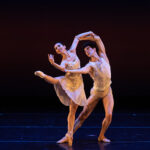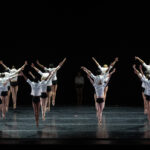While there are many notable ballet dancers, these are the ones that will always be known for their contributions that transformed history.
Vaslav Nijinsky
Vaslav Nijinsky is considered to be the greatest male dancer of the early 20th century. Nijinsky was born in Kiev, Russian Empire (now Ukraine), but considered himself to be Polish. He was introduced to dance at a very young age, given both of his parents were dancers for the Setov opera company. In 1900, Nijinsky joined the Imperial Ballet School and by 1907 he began taking starring roles and soon after became a member of the Imperial Ballet.
In 1909, Nijinsky joined the Ballet Russes, where he became the company’s star male dancer. He was credited for choreographing several original ballets including L’après-midi d’un faune (1912) to music by Claude Debussy, Jeux (1913), and Till Eulenspiegel (1916).
Nijinsky was known for his legendary gravity-defying leaps and being able to dance en pointe, which was rare for male dancers at the time.
Mikhail Fokine (Fokin)
Another legendary ballet dancer, Mikhail Fokine was born in Saint Petersburg and began dancing at the age of 9 years old. After performing in several ballets, including Paquita, Fokine wanted to see a change in traditional ballet. He believed that ballet could be utilized in communicating the natural beauty of man and that movement should be expressive and evoke real emotion.
Fokine also experimented with shifting away from only lower body movement to using the full body to unify motion with emotion and forming a connection to the soul. This led to ballet being expressed as a language and an art rather than undefined movement.
Anna Pavlova
Anna Pavlova was a Russian prima ballerina in the late 1800s, early 1900s. She was most recognized for her role in The Dying Swan and becoming the first ballerina to travel the world. She was accepted into the Imperial Ballet School at the age of 10 and went on to dance for the principal company as well as the Ballets Russes. However, after only dancing one season for Ballets Russes, she created her own company where she began touring internationally.
Pavlova was a major influence on female dancers, as she brought ballet to countries who have never seen it before. Her travels took her several thousand miles away including trips to South America and India.
Rudolf Nureyev
Named “Lord of the Dance,” Rudolf Nureyev (1938-1993) is considered to be the best male ballet dancer of his time. He was a contemporary dancer and accomplished choreographer, producing his own interpretations of classical works such as Swan Lake, Giselle and La Bayadére. Nureyev was director of the Paris Opera Ballet for six years and its chief choreographer until a year before his death.
Rodolf Nureyev is known for changing the perception of male dancers. In his choreography, he purposefully gave men more roles. Nureyev is also credited for crossing classical ballet and modern dance as he was known to perform both.
Mikhail Baryshnikov
Mikhail Baryshnikov is a Soviet-born Russian and American dancer, choreographer and actor. Beginning his career with the Kirov Ballet in Leningrad, he moved to North America in 1974 and joined the American Ballet Theatre as a principal dancer. In 1978, he joined the New York City Ballet where he worked alongside George Balanchine and Jerome Robbins. Baryshnikov co-founded the White Oak Dance Project, a twelve-year-long project aimed to expand the repertoire and visibility of American modern dance. He continued his career in acting making appearances in several movies and TV shows and is still active today.







